CHANGES TO PRIVATE HEALTH INSURANCE
What do they mean for people with musculoskeletal conditions?
Things to remember | What are the changes? | Extras cover | Private hospital cover | Hospital treatment by clinical category | Weighing up your options | Other options | Final word | How we can help | More to explore | Download PDF
Things to remember
- The Australian Government introduced several changes as of 1 April 2019 to simplify private health insurance.
- Many types of complementary therapies can no longer be claimed through your private health insurance.
- Private hospital coverage now consists of 4 tiers – basic, bronze, silver and gold – to help you compare similar products across different insurers.
- Take time to do your research so you can make informed decisions about private health insurance based on your own unique situation.
The Australian Government has made changes to private health insurance effective 1 April 2019.
What are the changes?
This information will focus specifically on the changes to both extras cover and private hospital cover that may affect people living with musculoskeletal conditions such as back pain, arthritis and osteoporosis.
Extras cover
From 1 April 2019 the following natural therapies are no longer covered by your extras: Alexander technique, Bowen therapy, Feldenkrais, kinesiology, naturopathy, Pilates*, reflexology, Rolfing, shiatsu, tai chi, and yoga.
There were several more removed, however these are the hands on manual therapies and exercise treatments that relate most to musculoskeletal conditions.
Because these are changes to government regulations, all health funds must comply. That means that excluded natural therapies were removed from all complying health insurance policies effective from 1 April 2019.
*Note: Clinical Pilates, delivered by a physiotherapist, will still be covered under physiotherapy care as part of your extras cover without any changes.
Why did this happen?
These therapies were removed after a government review from 2013 found that there wasn’t enough evidence that they were effective. However there are many problems with this review:
- The review found evidence for some of the natural therapies on the list, but excluded them because the evidence was limited to specific conditions or situations.
- It’s out of date. The government review included systematic reviews** that were published between 2008-2013. There has been more than five years of additional research that may have had an impact on the findings of the government’s review.
- The review focused on the effectiveness of these therapies for treating health conditions. It didn’t look at the effect some of these therapies, such as Pilates, tai chi and yoga may have on prevention of health conditions by helping people remain physically active.
- There’s no process for updating the list of therapies, or reintroducing any of the therapies, if/when evidence emerges that they’re effective in treating health conditions. For example, recent research has shown that yoga is an effective treatment for back pain, however you can’t claim it through your health insurance. These therapies will remain excluded from private health insurance until legislated otherwise.
** Systematic reviews are used to make sense of large amounts of information related to a specific question. Researchers use systematic methods to identify, select and critically appraise relevant research. They then extract and analyse data from the studies in order to answer the research question.
Private hospital cover
Another change that was introduced on 1 April 2019 involves private hospital cover, which now includes 4 tiers of cover: basic, bronze, silver and gold. Each tier has a minimum set of treatments that must be covered. Insurers can choose to add additional treatments to these tiers if they choose.
These tiers are meant to help consumers compare different insurers’ coverage more easily.
So, for example, by being able to compare insurer A’s basic cover to insurer B and C, you can see which policy best meets your needs.
Insurance companies have until 1 April 2020 to adopt these tiers.
It’s important that you look carefully to see what’s included in each of the tiers.
What are the clinical categories for private hospital cover as they relate to musculoskeletal conditions?
Hospital treatment by clinical category
Yes = minimum requirement of the product tier
(R) = insurers are allowed to offer cover for this clinical category on a restricted basis/with limited benefits
Optional = optional for insurer to include – not a minimum of the product tier
For the complete list of clinical categories, visit the Australian Government website.
Rehabilitation
Hospital treatment for physical rehabilitation for a patient related to surgery or illness. For example: inpatient and admitted day patient rehabilitation.
- Basic – Yes (R)
- Bronze – Yes (R)
- Silver – Yes (R)
- Gold – Yes (R)
Bone, joint and muscle
Hospital treatment for the investigation and treatment of diseases, disorders and injuries of the musculoskeletal system. For example: carpal tunnel; fractures; hand surgery; joint fusion; bone spurs.
- Basic – Optional (R)
- Bronze – Yes
- Silver – Yes
- Gold – Yes
Joint reconstructions
Hospital treatment for surgery for joint reconstructions. For example: torn tendons; rotator cuff tears; damaged ligaments.
- Basic – Optional (R)
- Bronze – Yes
- Silver – Yes
- Gold – Yes
Pain management
Hospital treatment for pain management that does not require the insertion or surgical management of a device. For example: treatment of nerve pain and chest pain due to cancer by injection of a nerve block.
- Basic – Optional (R)
- Bronze – Yes
- Silver – Yes
- Gold – Yes
Podiatric surgery (provided by a registered podiatric surgeon)
Hospital treatment for the investigation and treatment of conditions affecting the foot and/or ankle, provided by a registered podiatric surgeon, but limited to cover for: accommodation; the cost of a prosthesis as listed in the prostheses list set out in the Private Health Insurance (Prostheses) Rules. Note: Insurers aren’t required to pay for any other benefits for hospital treatment for this clinical category but may choose to do so.
- Basic – Optional (R)
- Bronze – Optional
- Silver – Yes
- Gold – Yes
Joint replacements
Hospital treatment for surgery for joint replacements, including revisions, resurfacing, partial replacements and removal of prostheses. For example: replacement of shoulder, wrist, finger, hip, knee, ankle, or toe joint; spinal disc replacement.
- Basic – Optional (R)
- Bronze – Optional
- Silver – Optional
- Gold – Yes
Pain management with device
Hospital treatment for the implantation, replacement or other surgical management of a device required for the treatment of pain. For example: treatment of nerve pain, back pain, and pain caused by coronary heart disease with a device (for example an infusion pump or neurostimulator).
- Basic – Optional (R)
- Bronze – Optional
- Silver – Optional
- Gold – Yes
Weighing up your options
If you have private health insurance, or you’re thinking about getting it, it’s really important that you think carefully about your own situation – specifically your health and finances. It’s easy to get confused and misled by advertising and the large amount of information that’s out there about health insurance. There are literally over 10,000 variations on health insurance, which makes it so complicated.
A good place to go for objective information that’s written to help consumers weigh up their options is Choice. They’re an independent consumer advocacy group and have developed lots of useful information on private health insurance. For more information, see the More to Explore section below.
It’s also important that you do sit down and do your homework. It can be tedious and confusing (even with the changes in place) but you owe it to yourself to understand the changes, how they may affect you, and what insurance you may need to get, or which insurer to switch to.
Using information developed by Choice and the government’s comparison website, you can make an informed decision about your health insurance.
There are other options
Private vs public
If you have private health insurance, you aren’t required to be treated as a private patient. You can choose to go to a public hospital as a public patient for free, and not pay the cost of the gap as you would as a private patient. However it’s likely that you’ll have a longer wait as a public patient for elective procedures (that aren’t urgent) and you won’t have as much choice about your care (for example choosing your own doctor, or having your own room).
It’s important to know there are no waiting lists for urgent procedures, (for example cardiac arrest, car accidents, major trauma) and you’ll be taken to a public hospital that’s best equipped to handle such events. Elective surgery, or surgery that’s non-urgent and you can elect not to have, is mostly done in private hospitals.
It’s also important to know that as a private patient, you’ll have out-of-pocket expenses. How much you will be out-of-pocket depends on many things, including your excess, the hospital you go to and if your doctor and anaesthetist have an agreement or relationship with your insurer.
As such, your out-of-pocket expenses for a specific treatment could range from several hundred dollars to several thousands; in fact $10,000 isn’t uncommon, even if you have full coverage. It’s best to check with your insurer beforehand as it may inform your decision to be admitted as a public or private patient.
Health savings accounts
Although not available in Australia, interest in this option is growing rapidly as ‘superannuation for health’. Major organisations such as the Australian Dental Association are advocating for this option. The idea behind it is that you have a savings account you regularly deposit money into (rather than to a health fund) for future dental and allied health care, rather than paying for extras. You would use it as you see fit, or as your needs evolve and change over time.
No insurance
Another option is not having health insurance at all. For some people, it’s just not financially possible to have private health insurance. If you don’t have insurance, you can still access the health system as a public patient. Australia has one of the best public systems in the world and if a problem is serious you’ll end up in a public hospital anyway not a private hospital.
The final word
Private health insurance is still complicated. The government has attempted to make the system easier to understand, and for consumers to have the information they need to get the best care. However it’s a confusing system that we all need to take time to research and make decisions based on our own unique set of circumstances.
How we can help
Call our National Arthritis and Back Pain+ Help Line and speak to our nurses. Phone 1800 263 265 or email helpline@msk.org.au.
We can help you find out more about:
- arthritis and musculoskeletal conditions
- ways to live well with these conditions
- managing your pain
- upcoming webinars, seminars and other events.
More to explore
- ABC News – Opinion: Private health insurance changes on Monday. This is what you need to know
- Australian Government – Clinical categories for hospital cover
- Australian Government – Private health insurance
- Australian Government – Private health insurance reforms
- Australian Government – Private health insurance reforms: Gold, Silver, Bronze, Basic product tiers
- Canstar – A guide to the 2019 health insurance reforms
- Canstar – Health insurance reforms 2019: What do I need to know about the new clinical categories?
- Choice – Health insurance
- Choice – Health insurance is changing
- Choice – Will private health insurance save you money?
- Consumers Health Forum of Australia – Making the right health insurance choice
- The Conversation – Premiums up, rebates down, and a new tiered system – what the private health insurance changes mean
Download this information sheet (PDF).
Produced in partnership with DMA Clinical Pilates Network.











